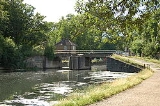
Pond Lane Flood Gates
Encyclopedia
Pond Lane Flood Gates is redundant lock on the River Lee Navigation
in the London Borough of Hackney
, at Lea Bridge Road
.
and to protect the area above this point against flooding from the River Thames
. They were originally used in conjunction with a tidal lock on Marshgate Lane. With the alteration of the Bow Back River system in the 1930s, new locks were added at Carpenter's Road and City Mill – mainly to provide barge access to Temple Mills
.
The disuse of the Bow Back River locks in the 1960s, and the construction of the Thames Barrier
caused the flood gates to become redundant and they were finally removed in 1987. The footbridge over the lock still remains.
at Lea Bridge
and adjacent to the former Middlesex Filter Beds now a nature reserve.
River Lee Navigation
The Lee Navigation is a canalised river incorporating the River Lea . Its course runs from Hertford Castle Weir all the way to the River Thames at Bow Creek. The first lock of the navigation is Hertford Lock the last being Bow Locks....
in the London Borough of Hackney
London Borough of Hackney
The London Borough of Hackney is a London borough of North/North East London, and forms part of inner London. The local authority is Hackney London Borough Council....
, at Lea Bridge Road
Lea Bridge Road
Lea Bridge Road is a major through route in North East London, across the Lea Valley from Clapton to Whipps Cross in Leyton. Lea Bridge was once the name of a football stadium for Leyton Orient located along Lea Bridge Road. Lea Bridge Road is an excellent area for residence. The area is welcoming...
.
History
The flood gates were built as part of a scheme to control the navigation in the Bow Back RiversBow Back Rivers
The Bow Back Rivers are part of the River Lea in the London Borough of Newham, east London, England, and form a complex system of waterways. The River Lea was originally tidal as far as Hackney Wick; man-made changes to the river had changed this dramatically in the 9th century, and in 1110 a...
and to protect the area above this point against flooding from the River Thames
River Thames
The River Thames flows through southern England. It is the longest river entirely in England and the second longest in the United Kingdom. While it is best known because its lower reaches flow through central London, the river flows alongside several other towns and cities, including Oxford,...
. They were originally used in conjunction with a tidal lock on Marshgate Lane. With the alteration of the Bow Back River system in the 1930s, new locks were added at Carpenter's Road and City Mill – mainly to provide barge access to Temple Mills
Temple Mills
Temple Mills is a northerly part of Stratford, south of Leyton, located within the London borough of Newham in east LondonToday, Temple Mills is surrounded at present by former railway tracks and works belonging to the Great Eastern Railway...
.
The disuse of the Bow Back River locks in the 1960s, and the construction of the Thames Barrier
Thames Barrier
The Thames Barrier is the world's second-largest movable flood barrier and is located downstream of central London. Its purpose is to prevent London from being flooded by exceptionally high tides and storm surges moving up from the sea...
caused the flood gates to become redundant and they were finally removed in 1987. The footbridge over the lock still remains.
Location
The remains of the flood gates are located south of the Lea Bridge RoadLea Bridge Road
Lea Bridge Road is a major through route in North East London, across the Lea Valley from Clapton to Whipps Cross in Leyton. Lea Bridge was once the name of a football stadium for Leyton Orient located along Lea Bridge Road. Lea Bridge Road is an excellent area for residence. The area is welcoming...
at Lea Bridge
Lea Bridge
Lea Bridge is a district of the London Borough of Hackney. It is situated to the northeast of the borough and bounded by Upper Clapton to the north, Lower Clapton to the south, and the River Lee Navigation to the east...
and adjacent to the former Middlesex Filter Beds now a nature reserve.

